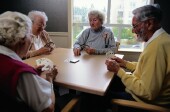
FRIDAY, Feb. 15 (HealthDay News) —
A new study of nursing homes in southern California found a drug-resistant and potentially deadly skin infection in 20 out of 22 facilities tested.
Researchers say the findings point to the need for more attention to the spread of drug-resistant infections, such as community-associated strains of methicillin-resistant Staphylococcus aureus (MRSA). Community-associated strains initiate in the general outside world instead of a hospital or other health care setting.
The strain of MRSA in question can lead to bloodstream infections, abscesses and pneumonia, and those in nursing homes are especially susceptible.
“Community-type strains first arose among healthy community members without exposure to the health care system and have steadily infiltrated many hospitals,” study author Courtney Murphy said in a news release from the Society for Healthcare Epidemiology of America.
“We believe these at-risk facilities could benefit from further infection control interventions, such as enhanced environmental cleaning or skin decolonization,” Murphy said. Until now, research into the spread of MRSA has focused on hospitals, not nursing homes, the news release added.
Because nursing homes encourage socializing, the measures needed to combat MRSA infection may differ from those used by hospitals.
In the study, published in the March issue of Infection Control and Hospital Epidemiology, researchers from University of California, Irvine, tested residents of 22 Orange County nursing homes between 2008 and 2011. At each facility, they swabbed the noses of 100 residents and as many as 100 new admissions.
Of those with MRSA, one-quarter had the community-acquired strain. It was more common in nursing homes with a greater number of patients younger than 65. This may be because younger people are more active and more likely to be exposed to MRSA in places like gyms, military facilities and child-care centers.
Also, the super bug was less common at admission than later on, suggesting that residents are transmitting it.
The community-acquired strain of MRSA was also more common in nursing homes with more Hispanic residents. Researchers think Hispanics may be at higher risk because of factors related to their culture or their genetics. It wasn’t more common among nursing homes with poorer residents.
More information
For more about MRSA, see the U.S. National Library of Medicine.

